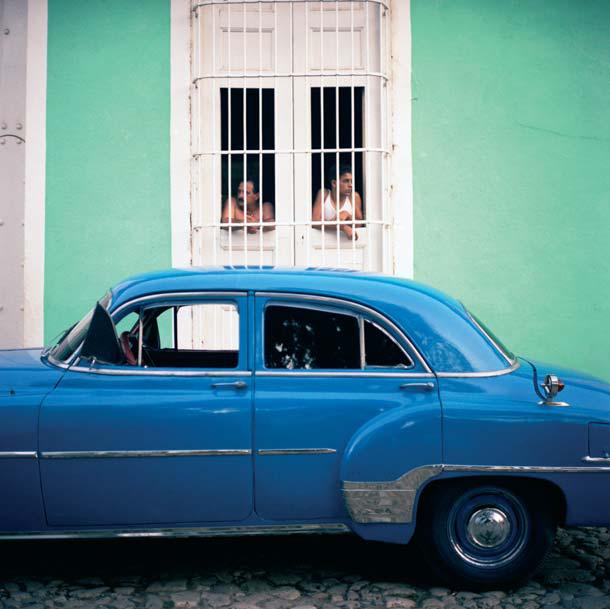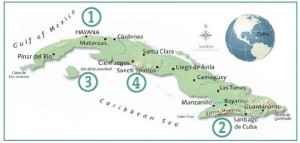 The first of January is a special day for many Cubans,but for a different reason from the rest of the world’s inhabitants. On this day the island celebrates not only the start of a New Year,but also the triumph of Fidel Castro’s army in 1959. The first of January is actually the most magical and expectant day of the year in a country that, for decades, reaffirmed its atheist character even in the Constitution, but has never stopped believing in miracles… and expecting them. On the evening of that day, as the floods of rum and the digestion of roast pork, which dismissed the old year subside to make way for lucidity,a group of the most experienced and wise babalaos, the priests of the cult of African origin (specifically Yoruba) known as Santería,gather to question the orisha Orula.This is the deity who gathers the words of Olofi, the head orisha, Lord of Time and the Future,and expert on the mysteries of the oracle of Ifá, through which people can penetrate the fate of the year that has just started. The ceremony, called the ‘letter (or sign) of the year’was brought to the island by African slaves,and has been practiced here since the nineteenth that recalls much of the Greek oracles, the ‘letter of the year’warns all Cubans, of any race, creed or political status,of the fortunes and dangers that await them in the coming months, and advises them how to ward off evil and encourage good.
The first of January is a special day for many Cubans,but for a different reason from the rest of the world’s inhabitants. On this day the island celebrates not only the start of a New Year,but also the triumph of Fidel Castro’s army in 1959. The first of January is actually the most magical and expectant day of the year in a country that, for decades, reaffirmed its atheist character even in the Constitution, but has never stopped believing in miracles… and expecting them. On the evening of that day, as the floods of rum and the digestion of roast pork, which dismissed the old year subside to make way for lucidity,a group of the most experienced and wise babalaos, the priests of the cult of African origin (specifically Yoruba) known as Santería,gather to question the orisha Orula.This is the deity who gathers the words of Olofi, the head orisha, Lord of Time and the Future,and expert on the mysteries of the oracle of Ifá, through which people can penetrate the fate of the year that has just started. The ceremony, called the ‘letter (or sign) of the year’was brought to the island by African slaves,and has been practiced here since the nineteenth that recalls much of the Greek oracles, the ‘letter of the year’warns all Cubans, of any race, creed or political status,of the fortunes and dangers that await them in the coming months, and advises them how to ward off evil and encourage good.
Since the beginning of the devastating economic crisis of the 90s (euphemistically called by the authorities ‘the special period in time of peace’), caused by the demise of the Eastern bloc and its economic aid to Cuba, predictions in ‘the letter of the year’acquired a popularity they had never enjoyed before. The slightest possibility of opening a window into the future,which might provide a glimmer of hope,resulted in an anxious search in the ‘beyond’for whatwas not to be found in the here and now.This, despite the fact that the predictions are usually rather pessimistic:epidemics, fights, violence and announcements of new shortages. My friend and neighbour,Lazaro Cuesta, is one of the babalaos who lead the interrogation made every January. At the end of the ceremony, he prints the text of the divine word and puts it on a wall of his home for all who are interested to glimpse into the future.
The practice of divination is done on amat on which several sacred seeds are thrown,and from the positions they take emerge a series of binary codes (1–0) that are recorded and then consulted on the ‘board of Ifá’,a kind of bible, where there are signs that lead babalaos towards the responses that will shape their predictions. If the ‘letter of the year’has become so well accepted and has generated such high expectations (several dozen foreign correspondents attended the press conference where the babalaos broadcast Olofi’s message to the world), it is not because Cubans are especially religious. I would say that, in reality,we are pragmatically religious, and the black Oracle is a fulfilment of this quality. More than amystical dialogue, it is an understanding between the lived and the possible experience,an equation that Cubans have had to grapple with every day during these past and most difficult years of national life,years of power cuts, food and transport shortages, and diaspora. It is a divination exercise that places a spiritual significance on the material plane, and encourages people in the search for the miracles of survival. Because,in fact,we Cubans have lived through many years of miracles and of expecting miracles. Although my being Cuban may make my views suspicious, I believe strongly that Cuba is a very special place: it is a country that enjoys an almost metaphysical condition that makes it far larger than its limited geography.
It is this propensity to the marvellous, this fated gigantism and disproportion, that has enabled us to become a universal reference. Music,ballet,sport, politics, tobacco,rum, the beauty of the Cuban women – are all themes and realities that cross the country’s borders and give us a prominence that sometimes fills us with pride and at other times scares us. Cuba was the first Latin American country to have a railway, to make telephone communications, to transmit television signals.Itwas the first to eliminate illiteracy and polio,and was the only one to send a man into space.And now they say that we are the most educated country in the world,although we have been the last in the Western world with free access to cellular telephony,an invention of the last century. But beneath these big issues – as certain and as manufactured as all issues are – there is a real life that can be very dramatic, precisely because of the character of the islanders.Perhaps the same historical pre-eminence makes the contrast more painful between the voluptuousness of Cuban realism,even more, its pragmatism, and a story that has filled us with responsibilities that many times we did not ask for – norwanted. A short while ago, as the new governmentof Raul Castro was announcing some of the recent changes, I asked a friend what he expected to happen in the future, whether or not he believed that there would be major changes in Cuba. His answer was a lightening bolt of illumination that I am sure is the highest aspiration of many Cubans:“ The only thing I want is for this to be a normal country, the most normal in the world, just to see for once if we can live calmly.” That is the miracle that Cubans aspire to now: whites, blacks, mulattos, Catholics, santeros, Protestants, atheists, Fidelistas, migrants, men, women, elderly, educated, uneducated, the idle and the workers. The miracle of normalcy, which never appears in the‘letter of the year’– towatch the sunset one balmy evening while breathing the smoke of a good cigar,drinking a glass of rum and catching the perfume of a good stew. Has this Cuban miracle ever happened? For themoment, only God and Olofi know.
Cuba Top Sights
- La Habana Vieja The capital’s old quarter is a wonderfully lively place, and buzzing with the past. This unesco protected area is full of narrow streets, refined colonial mansions,countless churches,cobblestone squares and sixteenth-century fortresses.
- Santiago De Cuba Known as the Ciudad Heroe – Hero City – the charming colonial city of Santiago was a focal point for revolutionary activity due to its proximity to the majestic Sierra Maestra,Castro’s mountainous battleground. The laid-back Santiagueros believe in having a good time:in July the city hosts the Fiesta del Feugo, one of Cuba’s liveliest carnivals,and it was also here that the energetic music called son originated.
- Isla De La Juventud One of 350 islands in the Archipélago de los Canarreos,this quiet and unhurriedisland was formerly a hideout for pirates,and inspired Robert Louis Stevenson’s Treasure Island. In the 1950s, Fidel Castro and his cohorts were imprisoned in the island’s Model Prison.
- Trinidad The most perfectly preserved colonial city in all of Cuba, known for its marvellous architecture,museums and art galleries.



